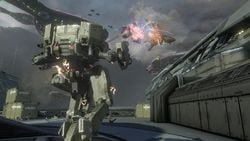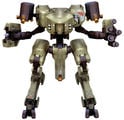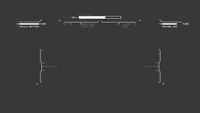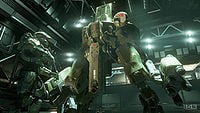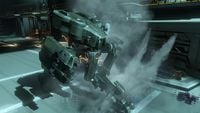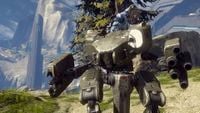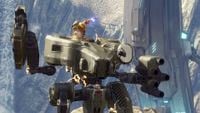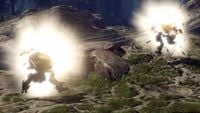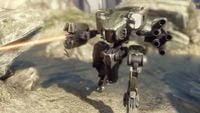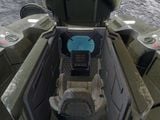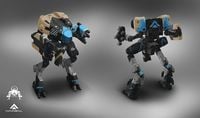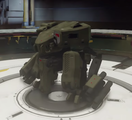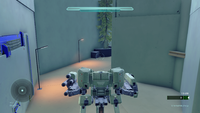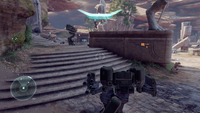HRUNTING/YGGDRASIL Mark IX Mantis: Difference between revisions
From Halopedia, the Halo wiki
No edit summary |
|||
| Line 49: | Line 49: | ||
==Operational history== | ==Operational history== | ||
Although the Mantis was first introduced into service with the [[United Nations Space Command]] in [[2403]], it saw limited use until after the [[Human-Covenant War]] when related MJOLNIR development began to filter down into other avenues of research through [[Project YGGDRASIL]].<ref name="universe"/> The Mantis was used during [[Human-Covenant War]], such as during the [[Battle of Meridian]] between [[2548]] and [[2551]], when the first prototype of the Mantis engaged in an action known as the "Cherbourg Run" successfully engaging eighteen heavily guarded [[Type-27 Mantis|Type-27 Anti-Aircraft Cannon]]s, which also bore the title of "Mantis". The success of the prototype in the "Cherbourg Run" is one of the theories behind the origin of the moniker of "Mantis".<ref>'''[[Halo 4: The Essential Visual Guide]]''', ''page 111''</ref> | |||
[[File:Mantis in action.jpg|thumb|250px|left|A Mantis during the Battle of Requiem]] | [[File:Mantis in action.jpg|thumb|250px|left|A Mantis during the Battle of Requiem]] | ||
Revision as of 03:58, March 26, 2016
| HRUNTING/YGGDRASIL Mark IX Mantis | |
|---|---|
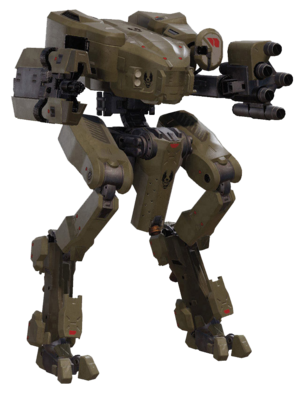
| |
| Production information | |
|
Manufacturer: |
|
|
Product line: |
HRUNTING/YGGDRASIL[1] |
|
Model: |
Mark IX[1] |
| Technical specifications | |
|
Length: |
2.8 meters (9.2 ft)[1] |
|
Width: |
5.8 meters (19 ft)[1] |
|
Height: |
5.7 meters (19 ft)[1] |
|
Mass: |
5.2 metric tons (5.1 LT; 5.7 ST)[1] |
|
Maximum speed: |
55.5 kilometers per hour (34.5 mph)[1] |
|
Armament: |
|
|
Crew: |
One operator[1] |
| Usage | |
|
Year introduced: |
|
|
In service: |
|
|
Role(s): |
Armor defense system |
|
Affiliation: |
|
The HRUNTING/YGGDRASIL Mark IX Armor Defense System,[2] commonly known as the Mantis, is a powered exoskeleton/armored fighting vehicle used by the UNSC Marine Corps, UNSC Army, Office of Naval Intelligence, and private security forces[1] after the Human-Covenant War.[4][5] It is derived, if tangentially, from the HRUNTING and YGGDRASIL teams' earlier Mark I Armor Defense System.[2]
Specifications
Design details
Standing roughly twenty feet tall and weighing over five metric tons,[1] the Mantis is similar in appearance to the larger HRUNTING/YGGDRASIL Mark II (D) armor system, which itself was the evolution of another HRUNTING project. Its spindly legs and tiny "thorax" give the Mantis a passing resemblance to its namesake, as do its weaponized arms. Though it lacks the sheer firepower and durability of the M808 Scorpion, the Mantis is far more maneuverable, requires one crew member, and is equipped with regenerating energy shields.[6][5] The Mantis integrates many features seen in the MJOLNIR Powered Assault Armor, such as the neural interface link, compact fusion power plant, and shield generator. The Mantis is capable of a maximum speed of 43.5–55.5 kilometers per hour (27–34.5 miles per hour).[1]
Armaments
There are two primary versions of the Mantis' weapon loadouts, both of which have an anti-matériel machine gun on the right arm and a missile pod on the left. One variant has a larger-caliber cannon and surface-to-air missiles; the other version has an M655 20mm heavy machine gun and M5920 35mm surface-to-surface missiles.[5] The Mantis does not currently feature modular hardpoints that allow armament swapping, though both the UNSC Marine Corps and the Army have contracted Materials Group to produce a refit package to allow alternate loadouts.[1]
Variants
Similar to the HRUNTING Mark III Cyclops, there are numerous variants of the Mantis that have proven useful for a whole host of varied functions.[7]
- Corp Mantis: Up-armored model used by the Liang-Dortmund Corporation. Liang-Dortmund occasionally loan their Mantises to local security forces for riot duty and shows of force. Their ammunition is usually replaced with non-lethal alternatives.[8] The corporation also employs non-combat variants that are used in their colony reclamation efforts for terrain navigation to mining operations.[7]
- Tundra Mantis: Variant designed for use in arctic environments and has more armor than the Corp variant.[8]
- Woodland Mantis: Variant features a woodland camouflage and more armor than the Corp variant.[8]
- Urban Mantis: Variant used by the UNSC Army and UNSC Marine Corps that features more armor than the Corp variant.[8]
- ONI Mantis: Variant used by the Office of Naval Intelligence that features more armor than other variants, multi-environment homing missiles and better heat sink shrouds for the heavy machine gun. [8]
- Hannibal Mantis: Variant developed by Hannibal Weapon Systems that features a rapid-fire gauss cannon, and experimental ion field missile warheads.[9]
Operational history
Although the Mantis was first introduced into service with the United Nations Space Command in 2403, it saw limited use until after the Human-Covenant War when related MJOLNIR development began to filter down into other avenues of research through Project YGGDRASIL.[1] The Mantis was used during Human-Covenant War, such as during the Battle of Meridian between 2548 and 2551, when the first prototype of the Mantis engaged in an action known as the "Cherbourg Run" successfully engaging eighteen heavily guarded Type-27 Anti-Aircraft Cannons, which also bore the title of "Mantis". The success of the prototype in the "Cherbourg Run" is one of the theories behind the origin of the moniker of "Mantis".[10]
After the Human-Covenant War, in early 2553, one Mantis was delivered to Kilo-Five aboard their prowler UNSC Port Stanley.[11] The Mantis continued to be in use only by select highly classified ONI units and UNSC Infinity,[2] which carried a number of Mantises by 2557. After Infinity was drawn inside the shield world Requiem, Spartan John-117 used a Mantis against Covenant remnant forces in the vicinity of the ship's crash site.[4] Several Mantises were used to defend Ivanoff Station.[12] Later that year, Infinity's Spartan-IV complement used a version with scaled-down weapons in War Games training.[5] During the Requiem Campaign, Fireteam Crimson was sent to rescue a squad of Marines trapped behind enemy lines. During the rescue attempt Crimson was met with overwhelming Covenant forces, Commander Sarah Palmer ordered mission handler Robert Dalton to deploy several Mantises to aid Crimson in holding off enemy forces.[13] Several Mantises were used in the defense of Magma Base.[14] During the attack on the Infinity, Lieutenant Murphy brought in a Mantis to support Fireteam Crimson in order to clear a landing zone.[15]
Later, when on their way back to activate the Harvester, Crimson used a salvaged Mantis to fight their way out of the Warrens.[16] Two Mantises were later deployed during the Battle of Aktis IV to fend off Covenant troops.[17] Two Mantises were used by Fireteam Osiris during the Battle of Nuusra on Sanghelios in order to save Arbiter Thel 'Vadam.[18] During the Battle of Genesis, Osiris used a Mantis in a effort to free Blue Team from Cortana.[19]
Gameplay
Halo 4
The Mantis has two variants, both in canon and in gameplay. The more powerful model, featured in the campaign and Spartan Ops, is designed to provide the player an almost overwhelming advantage. To promote more balanced competitive play, the Mantis has less firepower in War Games and has anti-surface rather than anti-air missiles. The player may fire all five missiles by holding the left trigger, while tapping the trigger fires only one missile, similar to the Type-52 plasma launcher in Halo: Reach. The player can stomp the ground with the Mantis' legs by pressing the melee button.[5] The Mantis is also capable of crouching to lower its profile. One major drawback about the Mantis is it has the longest recovery time from being EMP'd. The time spent standing perfectly still is a death sentence in the campaign on higher difficulty levels. The Mantis's energy shields also take a very long time to begin recharging, and even longer for it to reach full shields again.
Halo 5: Guardians
- The Mantis in Halo 5: Guardians can no longer fire its missiles one at a time. Instead all five are fired continuously, similar to the M79 rocket launcher. They are also capable of locking onto multiple enemies.
- The auto-cannon has reticule bloom and becomes more inaccurate the longer it's fired.
- Its shields recharge in full in one second, where as in Halo 4 they took ten seconds to fully recharge.
- The vehicular HUD has been reduced to the auto-cannon's reticle, with no HUD indicators for the missile or shield status.
- The Mantis can be boarded from the front.
- The Mantis now comes in multiple variants for use in multiplayer.[8]
Production notes

|
See our gameplay information related to HRUNTING/YGGDRASIL Mark IX Mantis on its gameplay page. |

|
Browse more images in this article's gallery page. |
During the early concept phase, 343 Industries considered implementing the HRUNTING/YGGDRASIL Mark I powered exoskeleton from the Halo Legends short Prototype. Later concepts derived from this design featured a larger exoskeleton that would cover the wearer's MJOLNIR armor. Designing the Mantis required months of playtesting, much of which involved tweaking the speed of the "stomp" move. One of the biggest concerns was making it clear when a player is reloading the Mantis' weapons; originally, the Mantis held its arms forward as the weapons were reloaded. Due to playtesters' feedback, the animation was changed so that the mech lifts its arms when new ammunition is being fed.[5]
The rear of the Mantis's legs and the back of the metal plate directly under the "thorax" cockpit section sport what appear to be rocket nozzles. These are never used in gameplay. Concept art (seen below) showed similar nozzles being attached to the vehicle's "shoulders".
Gallery
Concept explorations for a "UNSC mech" which would eventually evolve into the Mantis for Halo 4.
A closeup view of an active Mantis on Ragnarok.
A Mantis being boarded by a Spartan-IV in War Games training.
A Mantis on Shatter.
A Mantis taking minor damage from an Unggoy Ranger.
A Mantis battling a T26 Wraith AGC.
A Mantis opening fire with its M655 Heavy Machine Gun/Anti-Matériel.
Two Mantises on the cover of Halo: Escalation #15.
Two Mantises during the Battle of Aktis IV.
Concept art of the Hannibal Mantis for Halo 5: Guardians.
A Mantis firing its missiles at a Phaeton on Raid on Apex 7.
Halo 5: Guardians variants
- Mantis.jpg
Mantis
- Corpmantis.jpg
Corp Mantis
- Urbanmantis.jpg
Urban Mantis
- ONImantis.jpg
ONI Mantis
List of appearances
- Halo: The Thursday War (First appearance)
- Halo 4
- Halo: Escalation
- Halo 5: Guardians
Sources
- ^ a b c d e f g h i j k l m n o p q Halo Waypoint: Mantis
- ^ a b c d e Halo 4 Interactive Guide (defunct)
- ^ Halo: The Thursday War, page 364
- ^ a b Official Xbox Magazine October 2012
- ^ a b c d e f The Halo Bulletin 10.17.12
- ^ Image showing energy shield flaring
- ^ a b Halo Waypoint: Canon Fodder - Greek Squad
- ^ a b c d e f Halo 5: Guardians
- ^ Halo Waypoint: Canon Fodder - Close Quarters
- ^ Halo 4: The Essential Visual Guide, page 111
- ^ Halo: The Thursday War, page 416
- ^ Halo 4, campaign level, Composer
- ^ Spartan Ops, S1E3 Catherine: Episode 3: Shootout In Valhalla
- ^ Spartan Ops, Episode 5, Chapter 4: "The Cauldron Base"
- ^ Spartan Ops, S1E7 Invasion: Chapter 1: Backup
- ^ Spartan Ops, S1E10 Exodus: Chapter 4: Out the Other
- ^ Halo: Escalation, Issue #15
- ^ Halo 5: Guardians, campaign level Swords of Sanghelios
- ^ Halo 5: Guardians, campaign level Guardians
